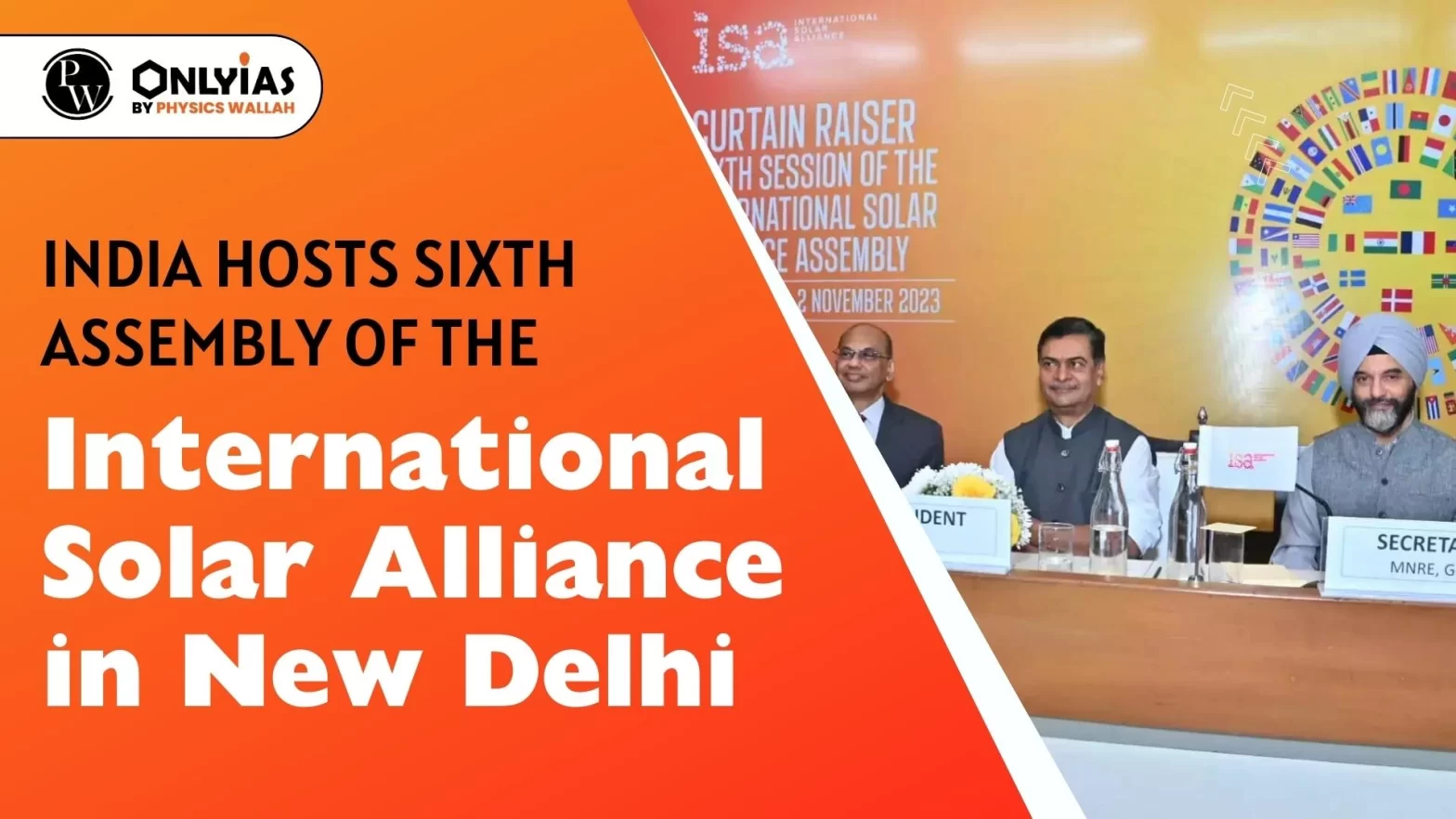Context:
- The Sixth Assembly of the International Solar Alliance (ISA) was hosted at Bharat Mandapam, in New Delhi.
Sixth Assembly of International Solar Alliance – Key Highlights
- The 6th Assembly of the International Solar Alliance has decided to increase viability gap funding(VGF) for projects from 10% up to 35%.
- VGF aims at supporting infrastructure projects that are economically justified but fall marginally short of financial viability
- India is considering a $25 million investment as a capital contribution to the Global Solar Facility.
- Need of International Solar Alliance: Around 80 percent of the global population, totaling a staggering 6 billion people, reside in countries that depend on fossil fuel imports.
Global Solar Facility (GSF):
- Global Solar Facility is a payment guarantee fund formed by the International Solar Alliance to stimulate investments into solar power projects.
- It is designed to catalyze solar investments in underserved segments and geographies across Africa.
|
What is the International Solar Alliance (ISA)?
- International Solar Alliance was established following the Paris Declaration at the UN Climate Change Conference on November 30, 2015.
- Secretariat: Gurugram, Haryana.
- Objective: To form a coalition of solar resource-rich countries to collaborate on addressing the identified gaps in their energy requirements through a common approach.
- Membership: International Solar Alliance was proposed as a multi-country partnership organization with membership from the ‘sunshine belt’ countries lying fully or partially between the Tropic of Cancer and the Tropic of Capricorn.
- However, the ambit has been subsequently expanded to include several European countries and the US as well.
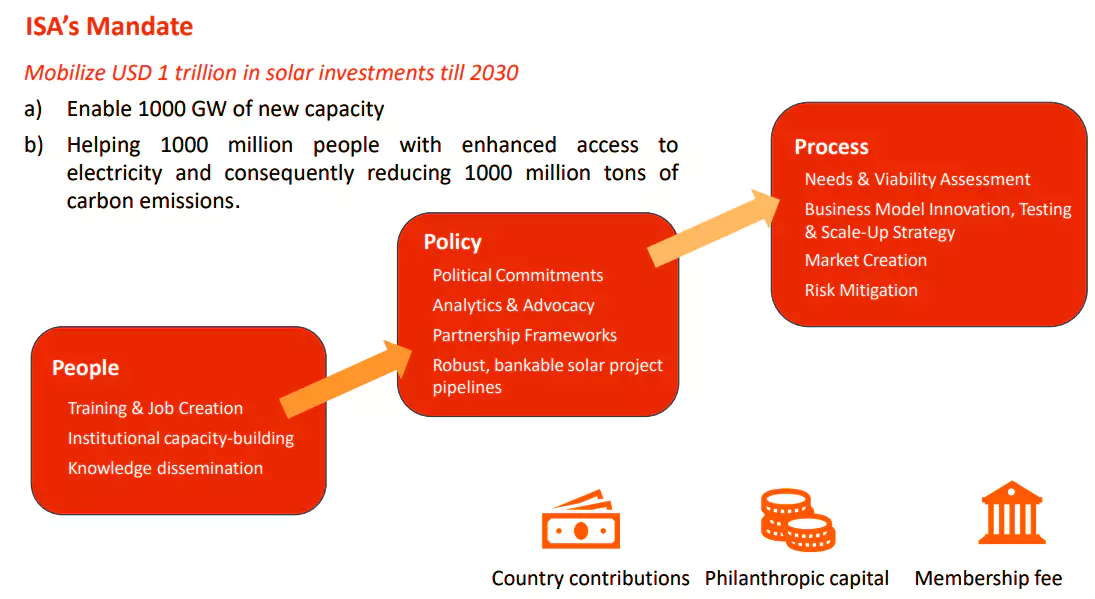
- Governance Structure: The Assembly of the International Solar Alliance is the apex decision-making body which comprises representatives from each Member Nation.
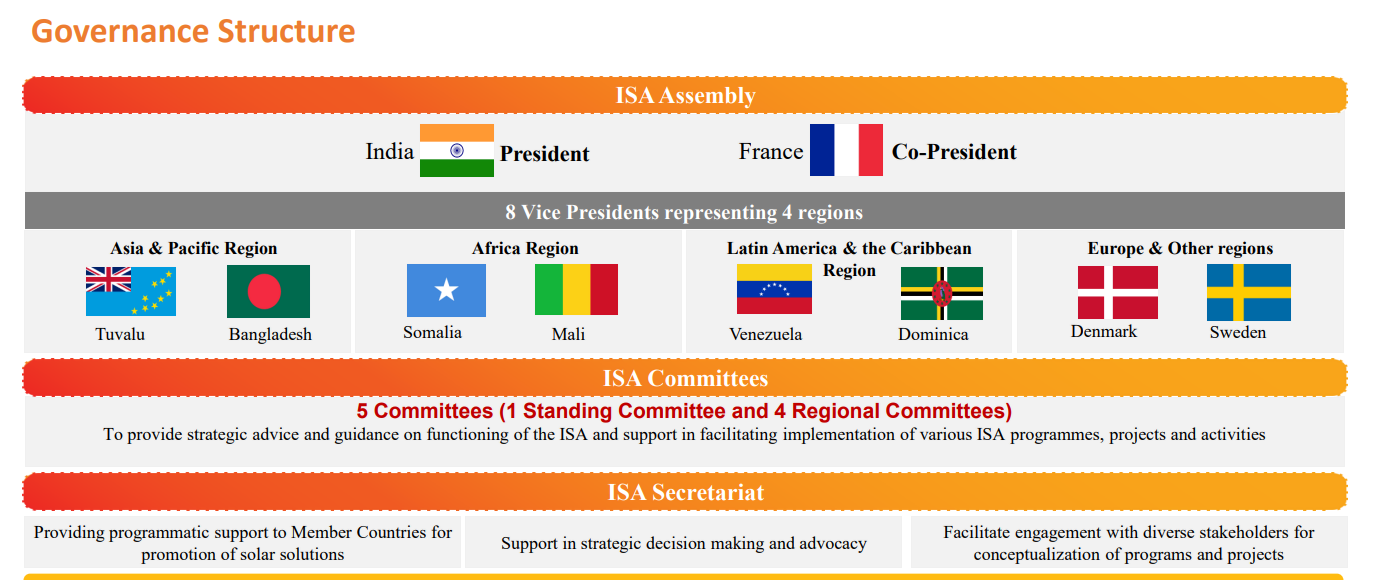
- Target: The International Solar Alliance has set a target of 1 TW of solar energy by 2030, which would require $1 trillion to achieve.
- Observer Status: The United Nations General Assembly granted observer status to the ISA on 9 December 2021.
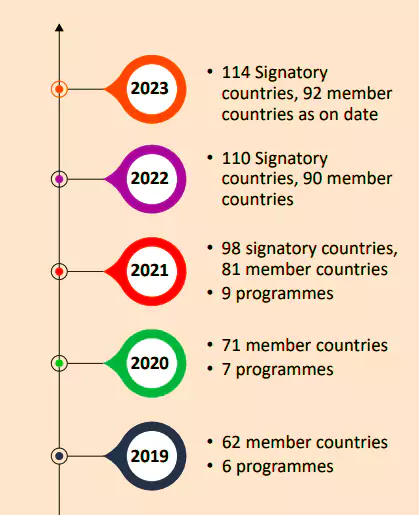
- Focus Areas of International Solar Alliance:
- Promoting solar technologies
- New business models and investment in the solar sector
- Formulate projects and programs to promote solar applications
- Develop innovative financial mechanisms to reduce cost of capital build
- Common knowledge e-Portal to facilitate capacity building for promotion and absorption of solar technologies.
What are the initiatives of the International Solar Alliance?
- One Sun, One World & One Grid: It aims to connect different regional grids through a common grid that will be used to transfer renewable energy power, especially solar energy.
- The idea for the One Sun One World One Grid (OSOWOG) initiative was put forth by India, at the First Assembly of the International Solar Alliance in October 2018.
- ‘Towards 1000’ policy’: To mobilize 1000 billion USD by 2030 to install 1000 gigawatts (GW) of solar energy capacity to provide energy access for 1000 million people.
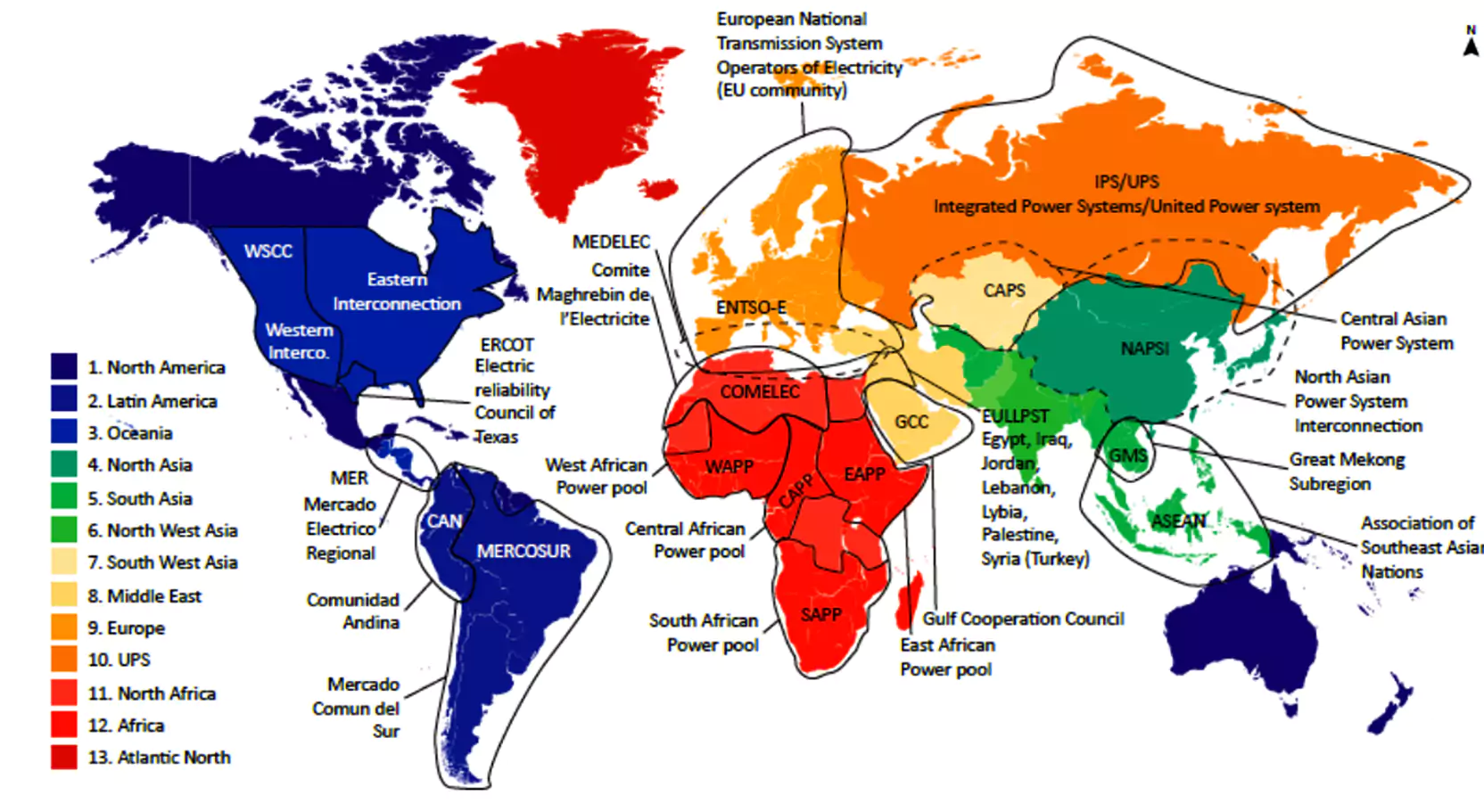
- Common Risk Mitigation Mechanism (CRMM): It aims to act as an insurance pool for financiers.
- Significance: The USD1-billion guarantee from this mechanism could attract up to USD15 billion in investments, which could set up 20 GW of solar PV capacity in more than 20 countries.
- Sustainable Renewables Risk Mitigation Initiative (SRMI): It aims to leverage private investments to support governments in developing, financing, and implementing sustainable solar programs and projects.
- The Affordable Finance at Scale and Scaling Solar Applications for Agricultural Use (SSAU) programs were launched together by India and France at a Ministerial side event on International Solar Alliance at the United Nations Headquarters in New York, in 2016.
- Scaling Solar Mini-Grids Programme: It aims to address the energy requirements of International Solar Alliance member nations in specific regions lacking a reliable grid or with no grid access at all.
- ISA’s Solar Facility: The Solar facility aims to catalyze solar investments in the underserved segments and geographies of Africa, thereby unlocking commercial capital.
- The facility would focus on investing across solar technologies – off-grid solar, rooftop solar, productive use solar, and utility-scale solar – across Africa through a country-specific intervention approach. The Solar Facility would comprise 2 funds:
- Solar Insurance Fund: The Solar Insurance Fund would accelerate solar project development in Africa via offsetting insurance premium-related expenses (during construction and pre-revenue stages).
- Solar Payment Guarantee Fund: The Solar Payment Guarantee Fund will support projects at the time of default and reduce the risk of early closures/bankruptcy of solar energy projects.
Also Read: India Records 76% Drop In Solar Module Imports From China
What challenges does the International Solar Alliance face?
- India’s Limited Material Capability: India, being a founder of International Solar Alliance suffers a major drawback as it does not possess significant material capability in the solar sector that can influence other players.
- For example, Dependency on Chinese Equipment, India heavily relies on Chinese solar equipment, with about 70% of the country’s solar capacity being built using Chinese-made solar equipment.
- Diverse Challenges and Perspectives Among ISA Member States: Many member states are developing countries with pressing priorities at home who have not always been able to articulate their solar needs well.
- Some member states, such as those in Southeast Asia, are not fully convinced about solar power itself while others are waiting for more successes before embracing solar power fully.
- Limited Global Solar Capacity: The International Solar Alliance was initially designed to cater to 121 countries lying in the sunshine-rich area between the Tropic of Cancer and the Tropic of Capricorn.
- These countries, most of which are poorer, account for nearly three-quarters of the world’s population but only 23% of global solar capacity.
- Challenges in Solar Markets of Smaller Countries: Solar markets in smaller countries are fragmented to attract investors, and governments often lack the know-how to differentiate among the various technologies and policies to find the best fit for their own needs.
- Land Acquisition Challenges: Land and water usage and ensuing ecological considerations have been a major part of solar power production in developing countries.
- India could be a case in point in this regard, where out of 57 solar parks commissioned by the government, only about 10 have been operationalized due to land acquisition concerns.
- Differentiating Itself from IRENA: The International Solar Alliance has emerged in what is already a crowded renewables ecosystem of multiple inter-governmental and global actors. Among the most prominent of these is the International Renewable Agency or IRENA.
- The International Solar Alliance will need to differentiate itself from IRENA, and it is not yet clear it will do so.
About IRENA: It is an intergovernmental organisation that supports countries in their transition to a sustainable energy future, and serves as the principal platform for international cooperation, a centre of excellence, and a repository of policy, technology, resource, and financial knowledge on renewable energy.
- Membership:168 countries and the EU
- Headquarters: Abu Dhabi, United Arab Emirates.
- India is the 77th Founding Member of IRENA.
|
India’s Role in International Solar Alliance
- Green Hydrogen Innovation Centre: The International Solar Alliance established the Green Hydrogen Innovation Centre (GHIC) at the initiative of India’s G20 Presidency in July 2023.
- Solarisation of healthcare centers in Africa: In August 2023, India through ISA inaugurated nine projects for the solarisation of healthcare centres and primary schools in Uganda, Comoros, and Mali.
- Capacity Building: The Indian government has backed the International Solar Alliance by offering solar energy training spanning 21 days under the Indian Technical and Economic Cooperation (ITEC) Scheme.
- For Example: During 2018–2019, 133 participants from 25 countries received training at the National Institute of Solar Energy in Gurugram, Haryana, India, with assistance from the ITEC scheme.
- Funding: The Export-Import Bank of India (EXIM Bank) has pledged to fund solar initiatives for scaling up affordable finance, totalling USD 1.4 Billion
- Supporting Infrastructure: Being a founding member, the Indian government contributed $27 million to the International Solar Alliance for building infrastructure and recurring expenditure over a 5-year duration from 2016-17 to 2020-21.
- Research & Development: India will also provide 500 training slots for International Solar Alliance member countries and start a solar tech mission to lead R&D.
Way Forward
- Reduce Dependence on China: With nearly 90% of it being imported from China, India has been in a hurry to build up domestic manufacturing capacity under Make-in-India program and with the ambitious scheme of Production-linked Incentives (PLI).
- Private-Public partnerships: One of the many immediate steps could be to get the private industry players in India in the solar field to visit the countries that have come on board the International Solar Alliance and forge vital international private-public partnerships.
- Fostering Leadership, Innovation, and International Collaboration in Solar Energy: Some of the best-performing states in India can be encouraged to show leadership in forging partnerships with renewable energy partners in the countries that are part of the alliance.
- Additionally, international experts in the field of solar energy can also be brought together to understand their case studies.
- Promoting Solar Investment Summits: In all the countries that have signed the International Solar Alliance agreement, renewable energy or specific solar energy investment summits or solar shows have to be organized and anchored by the International Solar Alliance periodically.
- Recognizing Solar Ambassadors: Inspiring Global Solar Advocacy: India could also pick and honor some credible and emerging solar ambassadors across the various countries that have signed the International Solar Alliance framework agreement and honor them annually or when the general assembly of the ISA takes place.
- This will showcase positive human stories as driving the global solar movement within the ambit of the International Solar Alliance in the times to come and inspire several others to join the movement
Also Read: Renewable Energy Intermittency – Challenges, Opportunities, and Way Forward
Conclusion:
The India-led International Solar Alliance for an equitable green energy transition for the Global South has taken significant steps towards funding, policy, technology, infrastructure and capacity building. However, success will depend on the commitment of Member Countries and international partners towards consistent efforts and devising practical strategies for addressing any challenges that may arise in its value chains, financing, and technology transfer while capitalizing on the agreed framework.
| Prelims Question (2016)
Consider the following statements:
1. The International Solar Alliance was launched at the United Nations Climate Change Conference in 2015.
2. The Alliance includes all the member countries of the United Nations.
Which of the statements given above is/are correct?
(a) 1 only
(b) 2 only
(c) Both 1 and 2
(d) Neither 1 nor 2
Ans: (a) |
| Mains Question (2022): Do you think India will meet 50 percent of its energy needs from renewable energy by 2030? Justify your answer. How will the shift of subsidies from fossil fuels to renewables help achieve the above objective? Explain. |
![]() 2 Nov 2023
2 Nov 2023
